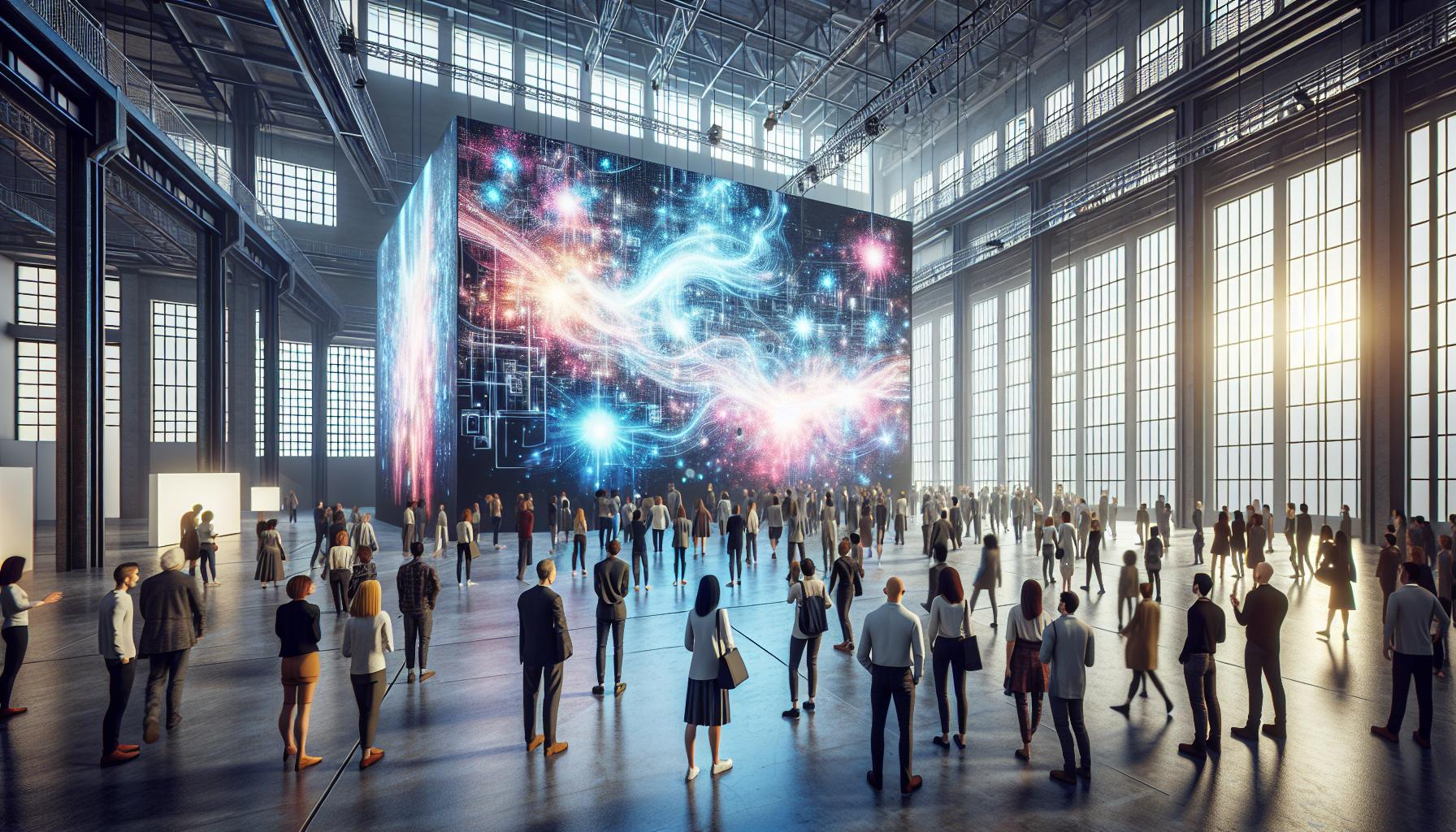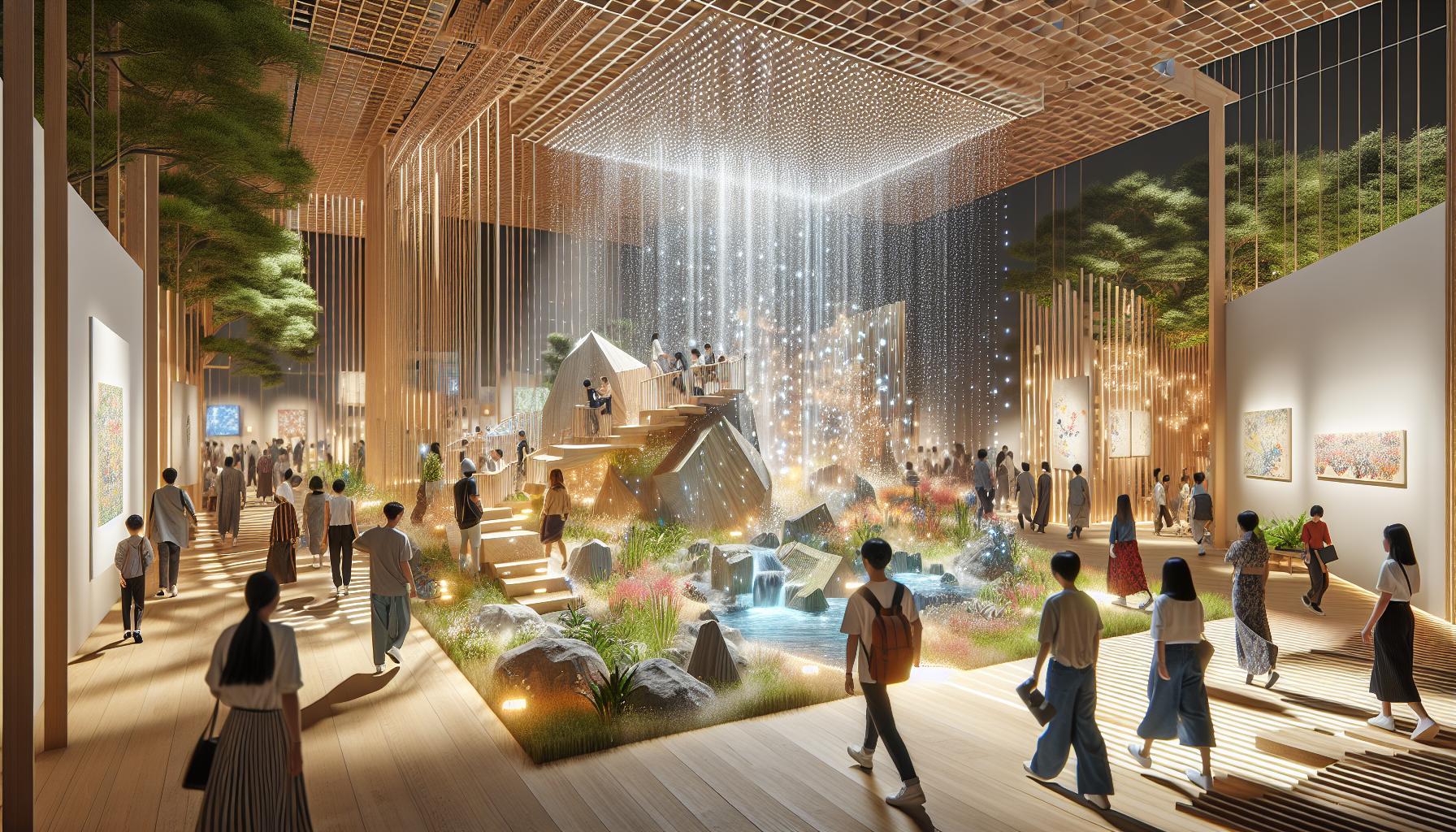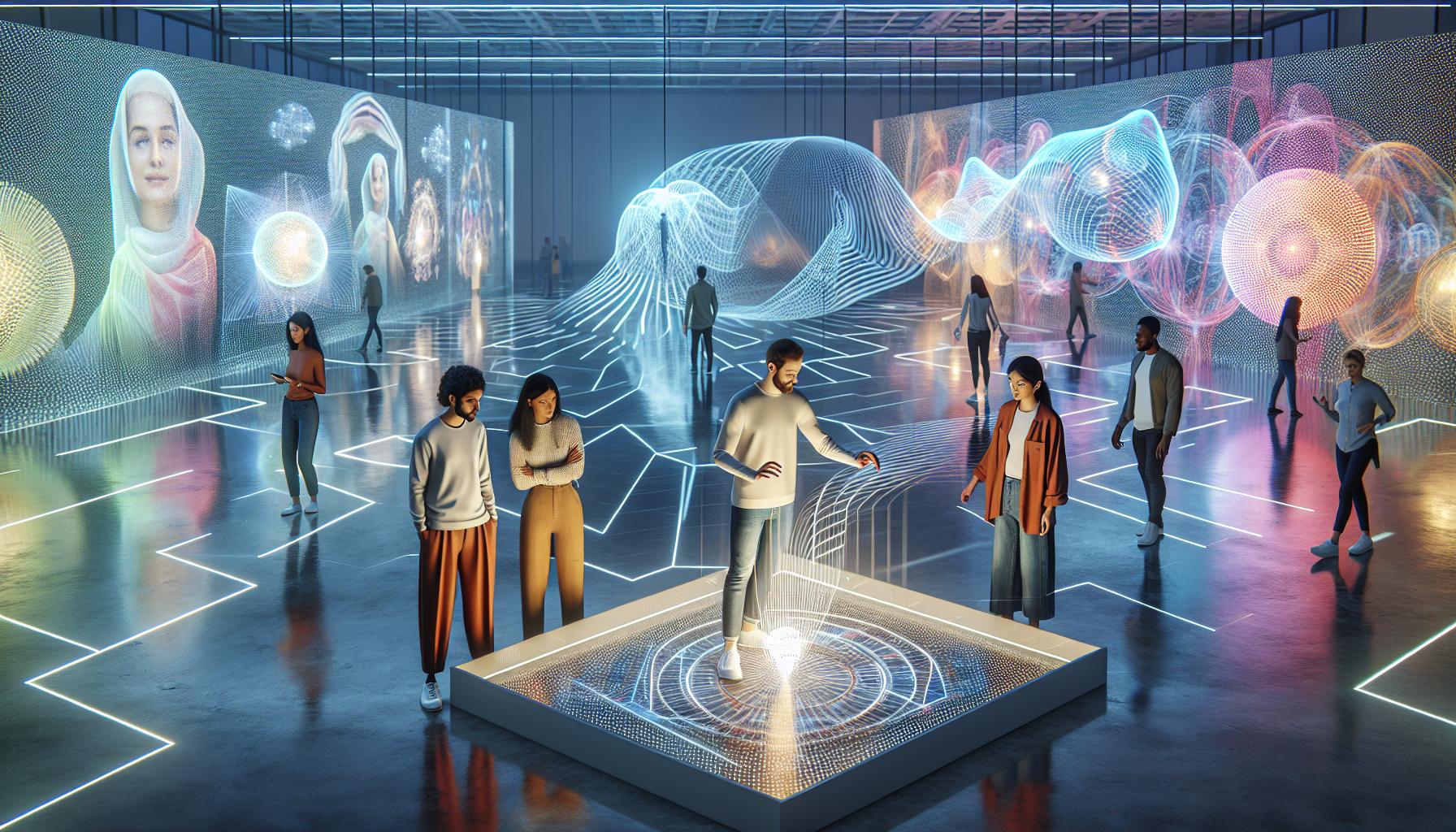Installation art transforms ordinary spaces into extraordinary experiences that challenge our perception of reality. Unlike traditional paintings or sculptures that sit quietly in museums, installation artwork commands entire rooms, buildings, or even outdoor environments to create immersive experiences that viewers can walk through, touch, and become part of.
Think of it as the ultimate artistic takeover where artists turn spaces into their creative playground. From suspended objects and projected lights to interactive soundscapes and digital elements, installation artists use every tool at their disposal to craft multi-sensory environments that blur the lines between art and reality. It’s like stepping into an artist’s imagination where the boundaries between viewer and artwork disappear.
What Is Installation In Art
Installation art transforms physical spaces into experiential environments through the strategic placement of objects, materials, sounds, lights, or digital elements. The medium emphasizes spatial relationships between artwork components while creating immersive experiences for viewers.
Key Characteristics of Installation Art
- Site-specificity: Installation artworks respond to or integrate with their physical location, incorporating architectural features, natural elements, or cultural context.
- Temporality: Many installations exist for limited periods, making their ephemeral nature part of their artistic significance.
- Viewer participation: The audience becomes an active participant by moving through, interacting with, or completing the artwork through their presence.
- Multi-sensory engagement: Installations stimulate multiple senses through sound, light, texture, movement or scent.
- Spatial awareness: Artists manipulate space as a fundamental element, creating environments that alter perception or challenge spatial relationships.
Historical Development of Installations
Installation art emerged in the 1960s alongside conceptual art movements. Artists like Allan Kaprow pioneered “environments” that broke from traditional gallery displays. The 1970s saw artists Marcel Duchamp Kurt Schwitters transform entire rooms into artistic statements. During the 1980s digital technology expanded installation possibilities through video projection light manipulation. Contemporary installations incorporate virtual reality augmented reality elements creating hybrid physical-digital experiences. Major institutions like the Tate Modern dedicate large spaces to rotating installation pieces recognizing the medium’s significance in modern art practice.
The Role of Space and Environment

The relationship between space and environment forms the foundation of installation art. Installation artists transform physical spaces into immersive experiences that engage viewers on multiple sensory levels.
Site-Specific Installations
Site-specific installations respond directly to their environmental context, incorporating elements of architecture, landscape or cultural significance. Artists create these works exclusively for particular locations, such as James Turrell’s Skyspaces that frame views of the sky through architectural apertures. The physical characteristics of a space—including dimensions, lighting conditions, acoustic properties—determine the artwork’s form and impact. Notable examples include Olafur Eliasson’s “The Weather Project” at Tate Modern’s Turbine Hall, which utilized the vast industrial space to create an artificial sun and atmosphere. Dan Flavin’s fluorescent light installations demonstrate how artists integrate existing architectural features to transform ordinary spaces into compelling visual environments.
Interactive Elements in Installation Art
Interactive installations invite physical participation from viewers, transforming them into active participants rather than passive observers. Motion sensors trigger changes in lighting, sound or digital projections based on visitor movement. Artists like Rafael Lozano-Hemmer create responsive environments where viewers’ actions influence the artwork’s behavior through technological interfaces. Digital installations by TeamLab incorporate real-time data visualization that responds to touch, movement or collective audience behavior. Sound artists like Janet Cardiff design audio walks that guide participants through specific locations while overlaying narrative elements onto physical spaces.
Materials and Techniques

Installation artists employ diverse materials and advanced techniques to create immersive environments that engage viewers on multiple sensory levels. The selection of materials ranges from everyday objects to cutting-edge technology, each chosen for its ability to convey specific artistic concepts and emotional responses.
Traditional vs Contemporary Materials
Traditional installation materials include wood, metal, fabric, glass, paper and found objects from everyday life. Contemporary artists incorporate industrial materials such as plastics, polymers, resins and synthetic fibers. Natural elements like water, soil, plants and rocks feature prominently in environmental installations. Technological components such as LED lights, sensors, microprocessors and digital displays expand artistic possibilities. Artists like Tara Donovan transform common items like plastic cups or toothpicks into large-scale sculptural installations, while Olafur Eliasson uses mirrors, lights and atmospheric effects to alter spatial perception.
Multi-Media Integration
Digital projections, motion sensors and interactive software create responsive environments that adapt to viewer presence. Sound elements incorporate speakers, microphones and audio processing systems to generate immersive soundscapes. Video installations utilize multiple screens, projectors and synchronized playback systems. Artists combine analog and digital tools to create hybrid experiences that blur physical and virtual boundaries. TeamLab’s digital art installations merge computer-generated imagery with physical architecture using advanced projection mapping techniques. Virtual reality headsets and augmented reality applications introduce new dimensions to installation experiences, allowing viewers to interact with digital elements in physical space.
Viewer Experience and Participation

Installation art transforms passive observers into active participants through direct engagement with the artwork. The interaction between viewer and installation creates unique personal experiences that evolve with each visit.
Immersive Aspects of Installations
Installation art engages multiple senses simultaneously through strategic environmental design. Visitors move through spaces filled with changing light patterns, ambient sounds, tactile surfaces, and responsive elements that react to their presence. Artists like Doug Wheeler create perception-altering environments using light and space manipulation, while Carsten Höller’s slides and mirrors encourage physical interaction. Interactive elements range from motion-activated projections to touch-sensitive sculptures that respond to viewer proximity. Notable examples include Random International’s “Rain Room” where visitors walk through falling water without getting wet and teamLab’s “Borderless” exhibitions featuring dynamic digital landscapes that respond to movement.
Temporal Nature of the Art Form
Installation experiences change based on time of day, seasonal variations, and viewer interactions. Natural light transforms James Turrell’s Skyspaces throughout the day, creating distinct viewing experiences at dawn versus dusk. Digital installations by artists like Rafael Lozano-Hemmer evolve through accumulated visitor interactions, storing and displaying past participant data. Environmental installations respond to weather patterns, temperature changes, and atmospheric conditions, making each viewing unique. Time-based elements include decomposing materials, melting ice sculptures, and growing plants that highlight the artwork’s ephemeral nature. Museums document these temporal changes through photography and video, preserving the installation’s various states.
Notable Installation Artists and Works
Installation art’s evolution features influential artists who redefined spatial art through groundbreaking works. Their contributions range from early experimental pieces to contemporary digital installations.
Pioneering Installation Artists
Marcel Duchamp introduced revolutionary installations with “Mile of String” (1942), transforming gallery spaces into intricate webs of string. Louise Nevelson created monumental assemblages like “Dawn’s Wedding Chapel” (1959), using found wooden objects painted in monochromatic colors. Allan Kaprow coined the term “environments” through works like “Words” (1962), filling rooms with text-covered rolls of paper. Joseph Beuys presented “7000 Oaks” (1982), combining sculpture with environmental activism by planting trees paired with basalt columns. Nam June Paik established video installation art through pieces like “TV Garden” (1974), integrating television sets with living plants.
Contemporary Masters
Olafur Eliasson creates environmental installations like “The Weather Project” (2003), featuring a giant artificial sun at Tate Modern. Yayoi Kusama transforms spaces through “Infinity Mirror Rooms,” using mirrors lights to create endless reflections. TeamLab develops digital wonderlands such as “Borderless” in Tokyo, combining technology with traditional Japanese aesthetics. Ai Weiwei addresses social issues through large-scale installations like “Sunflower Seeds” (2010), featuring millions of hand-painted porcelain seeds. Random International engages viewers through interactive works like “Rain Room” (2012), allowing participants to walk through falling water without getting wet.
Cultural Impact and Significance
Installation art reshapes cultural landscapes by challenging traditional art viewing experiences. Its significance extends beyond aesthetic value to influence social discourse environmental awareness through immersive experiences.
Installation Art in Museums
Major museums embrace installation art to create transformative visitor experiences. The Guggenheim’s rotunda hosts large-scale installations like Maurizio Cattelan’s “All” (2011), suspending 128 sculptural pieces from the ceiling. The Tate Modern’s Turbine Hall commissions draw millions of visitors annually, featuring works like Olafur Eliasson’s “The Weather Project” which attracted 2 million visitors in 2003. Installation art transforms museum spaces into active environments where visitors engage directly with contemporary artistic expressions. Museums incorporate permanent installations like James Turrell’s Skyspaces into their architectural design, creating lasting cultural landmarks that enhance institutional identity.
Public Space Installations
Public installations democratize art access by bringing immersive experiences to everyday environments. Anish Kapoor’s “Cloud Gate” in Chicago’s Millennium Park attracts 12 million visitors annually, becoming a cultural icon. Light installations like Leo Villareal’s “The Bay Lights” on San Francisco’s Bay Bridge transform urban infrastructure into dynamic artworks. Artists create site-specific installations in parks squares shopping centers to engage diverse audiences. These public works spark community dialogue generate social media engagement shape city identities through their presence in shared spaces. Environmental installations like Christo Jeanne-Claude’s wrapped landmarks challenge perceptions of familiar locations while creating temporary cultural phenomena.
Installation art stands as a revolutionary force in contemporary art making the viewer an essential part of the artistic experience. Through its unique blend of space environment and interaction it continues to push the boundaries of artistic expression beyond traditional limitations.
The fusion of technology materials and creative vision enables artists to craft transformative experiences that resonate with audiences on multiple sensory levels. As museums galleries and public spaces increasingly embrace installation art it’s clear that this dynamic medium will continue to shape the future of artistic expression and cultural engagement.
This innovative art form serves as a powerful reminder that art isn’t just about observation – it’s about immersion participation and transformation. It challenges both artists and viewers to reimagine the possibilities of creative expression in our ever-evolving world.



